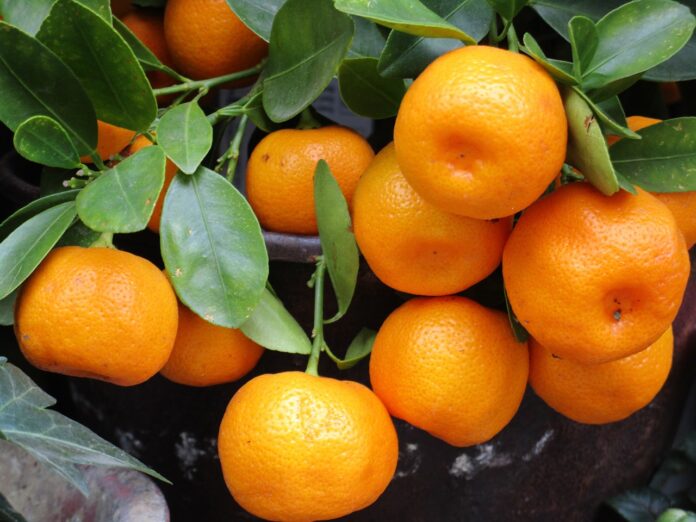Mandarin oranges (Citrus reticulata) are small, easily peelable fruits belonging to the Rutaceae family. They are believed to have originated in Southeast Asia, particularly China, and have been cultivated for over 3,000 years. Known for their thin, loose skin and sweet, juicy segments, mandarins are a favored fruit across the globe and are often considered a symbol of good fortune and prosperity in many Asian cultures, especially during the Lunar New Year celebrations
Interesting Facts About Mandarin Fruit:
- Mandarins are small, orange-colored citrus fruits: These fruits are distinguished from regular oranges by their size and sweetness. Their thin, loose skin makes them incredibly easy to peel, which is why they are often considered “kid-friendly.” The compact size makes mandarins a popular on-the-go snack
- The fruit’s name originates from the robes worn by ancient Chinese officials: These officials, known as “mandarins,” wore bright orange robes symbolizing prestige and wisdom. The resemblance of the fruit’s vibrant color to these garments is how mandarins got their name
- Global Production Record: Mandarin oranges have a massive presence in global agriculture, with an annual production surpassing 35 million tons. China leads the world, contributing over 50% of the total yield, followed by countries like Spain and Turkey. This scale of production showcases the fruit’s global importance and consumption rate
- Mandarins are believed to have originated in Southeast Asia: Specifically, the fruit’s history is deeply rooted in ancient Chinese agriculture, with cultivation dating back at least 3,000 years. They were later introduced to Europe in the early 19th century and gained popularity worldwide
- China is the largest producer of mandarins: As of recent statistics, China contributes over 50% of the world’s mandarin production, reflecting the fruit’s strong cultural and agricultural ties to the country. Other significant producers include Spain, Brazil, and Japan
- Several varieties of mandarins exist, including clementines, tangerines, and satsumas: Clementines are known for being seedless and sweet, making them ideal for children. Satsumas are usually easier to peel and are often cultivated in colder climates. Tangerines, on the other hand, have a slightly more tart flavor
- Mandarins are rich in vitamin C: Just one mandarin can fulfill about 80% of your daily vitamin C needs, which is crucial for maintaining a strong immune system. They also provide vitamin A, which is important for eye health, and dietary fiber, which aids in digestion and helps control blood sugar levels
- Essential oils from mandarin peels have commercial value: These oils are used extensively in flavoring liqueurs, soft drinks, and baked goods. The oils also have a place in aromatherapy and cosmetics due to their refreshing and calming scent
- Mandarins have a short shelf life compared to other citrus fruits: Typically, they begin to lose quality after about two to four weeks, especially when stored at room temperature. To extend their freshness, mandarins are best stored in a refrigerator
- The number of seeds in mandarins varies by variety: Some, like clementines, are typically seedless, while others, like tangerines, may have a significant number of seeds. Breeding programs have developed several seedless varieties to cater to consumer preferences
- Mandarins are linked to holiday traditions in North America: They are often included in Christmas stockings, a tradition that dates back to the 19th century. The fruit’s arrival from Asia in the late 1800s made it a winter luxury, and it has remained a seasonal favorite ever since
- Mandarin peel has uses in traditional medicine: In various cultures, dried mandarin peel is used to treat digestive issues and reduce phlegm. It is believed to have anti-inflammatory and antimicrobial properties that can benefit overall health
- Satsuma mandarins are among the most cold-tolerant citrus fruits: They can withstand temperatures as low as 20°F (-6°C), making them suitable for growing in regions that are too cold for other citrus species. This resilience has contributed to their cultivation in places like California and the southeastern United States
- Hybrid varieties like tangelos and minneolas have gained popularity: These hybrids combine the desirable traits of mandarins with other citrus species. Tangelos are a cross between tangerines and pomelos or grapefruits, while minneolas are known for their bell shape and tangy flavor
- Mandarins are grown on terraced slopes in Japan: This unique cultivation method allows the trees to benefit from maximum sunlight and the warm breezes of the nearby ocean, which helps to develop their sweet flavor. “Mikan,” a Japanese mandarin variety, is highly celebrated in the country
- Mikan mandarins are a traditional Japanese winter fruit: They are often eaten during the colder months and are considered a symbol of comfort and warmth. Japanese households frequently enjoy them while sitting under a heated table called a kotatsu
